|

Vought F-8E/J Crusader

The Vought F-8E was central to the
Tonkin Gulf incident, which led to America's direct intervention in the
Southeast Asian crisis, when on August 2, 1964, aircraft defended US Navy
units from attack by North Vietnamese motor torpedo boats. Four Crusaders
of the VF-53 Squadron from the aircraft carrier USS Ticonderoga, sunk an
enemy vessel with missiles and gunfire, thus initiating a war that did not
end until 1973.
From 1964 to 1969, during which time the
Crusaders were gradually replaced on US Navy aircraft carriers by F-4B
Phantoms, the F-8s, designed as daytime supersonic fighters, were also
largely employed in strike missions mostly over North Vietnam, carrying up
to 5,000 lbs (2,268 kg) of bombs under the wings. The first encounter
between F-8Es and MiG-17s took place on July 12, 1967, and after that date
the Crusaders frequently took on the North Vietnamese fighters, emerging
from battle with a tally of fifteen MiG-17s and three MiG-21s shot down in
dogfights, for the loss of only three planes. However, another 53 F-8Es
and F-8Js fell victim to North Vietnamese anti-aircraft batteries, and a
further 58 were destroyed while in action as a result of various causes.
An important support role was also
played by the RF-8 reconnaissance planes, 38 of them being lost through
anti-aircraft fire, SAM missiles or accidents. All US Navy aircraft
carriers engaged in the war were equipped with Crusader squadrons, the
most successful of these being the VF-121 which chalked up six victories
in fights with MiGs. Although there was no cause for regret in their
replacement by the McDonnell F-4B Phantoms, the Crusaders ranked third as
'MiG killers' in Vietnam, after the Phantoms themselves and the Republic
F-105s.
The first daytime supersonic carrier
based interceptor, the Crusader was conceived in 1952, built to the order
of the US Navy. The prototype flew on March 25, 1955, successfully testing
the original solution of a wing of variable incidence, designed to reduce
the velocity and improve landing capability. Production started soon
afterward and, up to 1965, 1,259 machines of various series were built,
increasingly powerful and up-to-date. The principal types were the F-8A
interceptor (first flight September 30, 1955, with 318 machines), which
went into service in March 1957; the F-8C air-superiority (187 machines,
first flight August 20, 1958); and the F-8D all-weather fighter (152
planes, first flight February 16, 1960). The final version was the F-8E
(first flight June 26, 1964), also designed as an all-weather fighter, of
which 286 were built. The Crusader remained in front line service until
the late 1970s, thanks to a massive modernization program starting in
1966, involving 375 planes from all series: 136 F-8Es, in particular, were
transformed into F-8Js, the modifications applying mainly to certain
structural components, the wings and the electronics.



Technical Specifications
Aircraft:
Vought F-8E
Year: 1964
Type: fighter
Manufacturer: Chance Vought Inc.
Engine: Pratt & Whitney J57-P-20A
Power: 18,000 lb (8,165 kg)
Wingspan: 35ft 8in (10.87m)
Length: 54ft 3in (16.53m)
Height: 15ft 9in (4.80m)
Wing area: 375sq ft (34.83mē)
Max take-off weight: 34,000 lb (15,422kg)
Max speed: 1,120mph at 40,000ft (1,802km/h at 12,192m)
Service ceiling: 58,000ft (17,678m)
Crew: 1
Load-armament: 4x20mm cannon; 5,000 lb (2,267kg)
|
